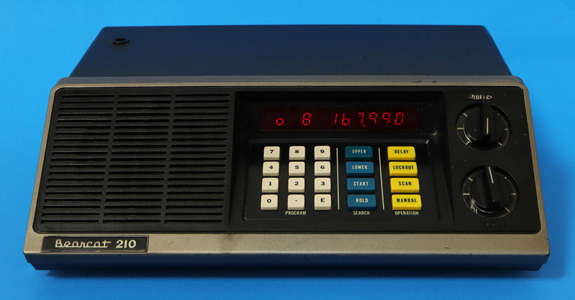
DATAMATH CALCULATOR MUSEUM
 |
DATAMATH CALCULATOR MUSEUM |
Electra Bearcat 210 (BC-210)
| Date of introduction: | October 1976 | Display technology: | |
| New price: | Display size: | ||
| Size: | 10.5" x 7.7" x
3.3" 267 x 195 x 85 mm3 |
||
| Weight: | 73.8 ounces, 2,092 grams | Serial No: | 0084734 |
| Batteries: | Mallory 10L123 (1.55 V) | Date of manufacture: | wk 32 year 1977 |
| AC-Adapter: | 117 V, 11 VA | Origin of manufacture: | USA |
| Precision: | Integrated circuits: | TMS0973 and many others | |
| Memories: | |||
| Program steps: | Courtesy of: | Joerg Woerner |

![]()
![]() While
working with Lex on the technology of the Regency "The Touch"
ACT-T16K Computer
Radio Scanner, he shared in an email to
Sean Riddle and
the Datamath Calculator Museum that Electra's Bearcat 210 (BC-210) Radio Scanner was
actually preceding the "The Touch" and might use a single-chip calculator
circuit manufactured by Texas Instruments as "Computing Brain".
While
working with Lex on the technology of the Regency "The Touch"
ACT-T16K Computer
Radio Scanner, he shared in an email to
Sean Riddle and
the Datamath Calculator Museum that Electra's Bearcat 210 (BC-210) Radio Scanner was
actually preceding the "The Touch" and might use a single-chip calculator
circuit manufactured by Texas Instruments as "Computing Brain".
![]() Sean
immediately acquired a BC-210, de-capped the NB733-03 ML980 marked chip and
shared his findings. The mysterious component is obviously a
TMS0970 chip in Revision F and part number
TMS0973B. Well that's not possible! The BC-210 is known for its large 10-digit
7-Segment LED Display and the TMS0970 is known from the
TI-1200 and
Little Professor as a cost-effective
member of the TMS1000 Microcomputer with 9 digit and 8 segment outputs.
Sean
immediately acquired a BC-210, de-capped the NB733-03 ML980 marked chip and
shared his findings. The mysterious component is obviously a
TMS0970 chip in Revision F and part number
TMS0973B. Well that's not possible! The BC-210 is known for its large 10-digit
7-Segment LED Display and the TMS0970 is known from the
TI-1200 and
Little Professor as a cost-effective
member of the TMS1000 Microcomputer with 9 digit and 8 segment outputs.
We
studied Sean's amazing photos of the TMS0973 from his Bearcat 210 scanner and
earlier photos of a TMS0974 from a
TI-1270 calculator to find out that
Texas Instruments indeed reduced the number of digit outputs of the original
TMS1000 from 11 to 9 to maintain the use of a
small 28-pin package when designing the TMS0950 but went for the
TMS0970 back to 11 digit outputs. With most TMS0970 applications being either
replacements of former TMS0950 designs or like four-banger calculators and
educational products using only 9-digit or smaller displays, the TMS0970 was
"usually" packaged in TMS0950-compatible packages. And with Texas Instruments
squeezing one of the two additional digit outputs between the four keyboard
inputs, neither schematics nor layouts would look good with the "11-digit"
TMS0970.
Understanding that as of today - almost 50 years
after the introduction of the TMS0970 - this Bearcat 210 scanner is the only
known application unleashing the full potential of the single-chip calculator
circuit, we decided to get our own unit for further research of its internals.
Dismantling a Bearcat 210 Radio Scanner with
Date code 7732 and manufactured in August 1977 by Electra Company in Cumberland, Indiana
reveals a very compact and efficient design with just three printed circuit
boards (PCBs):
|
• Main-PCB: 2 separate varactor diode tuned frontends for the Low/High VHF (32-50 MHz, 146-174 MHz) and UHF (416-512 MHz) bands. 1st IF filter (10.8 MHz), 2nd IF filter (400kHz), FM discriminator and squelch circuit, Synthesizer, VCO, Oscillator, PLL circuit, power audio amplifier, TMS0973B single-chip calculator chip and power supply • Keyboard-PCB: 20 conductive rubber switches arranged in an 8*3 matrix • Display PCB: 10 7-Segment LED Display |
![]()
Here at the Datamath Calculator Museum we consequently
focus on the the B733-2 ML980 marked TMS0973B chip and its interaction with the Keyboard-PCB,
Display-PCB and other components on the Main-PCB. Lex provided us with the
Service Manual of the Bearcat 210 Radio Scanner and Electra provided us with a
TMS0973B mounted in a socket for easy repair. The TMS0973B single-chip
calculator is using 10 of its 11 R Outputs with discrete transistors to drive
the common cathodes of the 10-digit LED display and the 8 O Outputs with
external transistors to drive the 7 A to G segments and decimal point of it. The
keyboard is connected in a 8*3 matrix to the scanning segment outputs of the
TMS0973B and the 3 K2, K4, and K8 Inputs. The remaining R10 Output and K1 Input
are used together with the 8 O Outputs to communicate with the Synthesizer
through its shift register. Two RS-Latches are used to control Read/Write
operation and Data I/O flow and two signals are used for other control of the
Synthesizer chip.
 Best
prerequisite for using our DCM-50A Platform
to allow the Characterization of Single-Chip Calculator Circuits
of the TMS0970/TMC0900 Family after already
studying a TI-1270 (TMS0974) calculator manufactured in
July 1976 and a
WIZ-A-TRON (TMC0907) educational toy assembled in
June 1978.
Best
prerequisite for using our DCM-50A Platform
to allow the Characterization of Single-Chip Calculator Circuits
of the TMS0970/TMC0900 Family after already
studying a TI-1270 (TMS0974) calculator manufactured in
July 1976 and a
WIZ-A-TRON (TMC0907) educational toy assembled in
June 1978.
If you have additions to the above article please email: joerg@datamath.org.
© Joerg Woerner, September 5, 2023. No reprints without written permission.